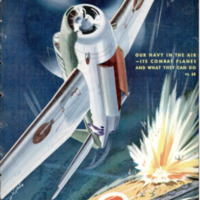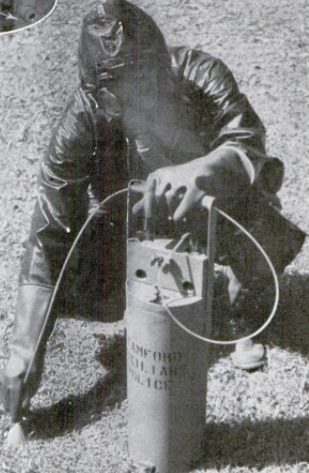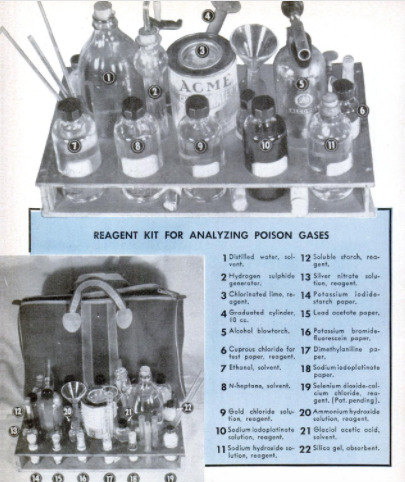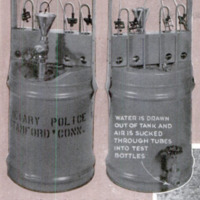-
Title (Dublin Core)
-
Chemical "Nose" sniffs poison gas
-
Article Title and/or Image Caption (Dublin Core)
-
Chemical "Nose" sniffs poison gas
-
extracted text (Extract Text)
-
GAS sentries of the Stamford, |
Conn., Auxiliary Police need
not depend upon their trained noses
alone to detect poison gases. These
sentries are members of the Ameri-
can Chemical Society who, accord-
ing to their battalion gas officer,
Lieut. Theodore F. Bradley, writing
in Chemical and Engineering News,
have devised civilian-defense equip-
ment to supplement the sense of
smell, which may be deceived by
lack of odor and other conditions.
The simplest detectors are test
papers that change color when ex- |
posed to certain gases. Potassium
iodide-starch paper, for example,
turns blue in the presence of chlo-
rine, bromine, and nitrous fumes.
Potassium bromide—fluorescein
paper changes from yellow to red
when exposed to chlorine. Both
papers are used moist. Filter paper
immersed in a solution of ten grams
of dimethylaniline in 90 grams of carbon
tetrachloride, and used dry, changes from
white to yellow or brown in the presence of
chlorpicrin, but the color soon fades.
Lead acetate paper, made with a solution
of ten grams of lead acetate in 90 cubic
centimeters of distilled water, darkens or
becomes black when exposed to hydrogen
sulphide.
The more sensitive test papers will react
to as little as pne part of chlorine or phos-
gene in a million parts of air, and need only
be exposed to the atmosphere. Those for
other gases require longer exposure, but
their use may be facilitated by placing |
them in the reagent bottles of a portable
aspirator designed by Lieutenant Bradley.
This device sucks air in through certain
indicator solutions or past test papers. No.
hand pumping or electrical connection is
necessary; the apparatus can be left to op-
erate alone or lowered into cellars.
Although an improved design of the as-
pirator is being put on the market, and all
commercial rights are reserved, Lieutenant
Bradley is willing for civilian-defense groups
to copv the device for their own use. |
A five-gallon solvent pail, fitted with a
pipe handle and water inlet and exhaust
valves, forms the body. Holes bored in a
thick block of wood hold four wide-mouthed
one-ounce reagent bottles. Peepholes allow
the contents to be seen. Copper tubes with
flexible plastic ends connect the bottles to
the large tank, which is filled with water.
‘When the water is allowed to flow from the
bottom valve, air is drawn in through the
several liquid reagents, which change color,
form precipitates, or otherwise react to the
presence of gases.
One of these reagents will indicate the
presence of any of four gases. The solution
is made by dissolving one gram of gold
chloride and one gram of concentrated
hydrochloric acid in one liter of distilled
water. Mustard gas turns it milky, carbon |
monoxide deep-purple, hydrogen sulphide
black, and sulphur dioxide pink.
A lye solution (20 grams of sodium hy-
droxide in 80 grams of distilled water) will
decompose lewisite and give off acetylene,
which can be detected with freshly prepared
cuprous chloride paper in a tube connected
with the reagent bottle.
Another reagent is made by dissolving
0.265 gram of sodium iodide in a small |
quantity of water, adding 0.05 gram of |
chloroplatinic acid separately dissolved in
two cubic centimeters of water, and diluting |
the mixture to 180 cubic centimeters. This
gives a colored solution that can be further
diluted with five to ten times its volume of |
distilled water. |
Carbon monoxide, sulphur dioxide, mus-
tard, and certain other reducing gases will
rob the solution of its color. If soluble starch
is added, mustard gas will turn it deep blue.
Pinch valves on the tubes make it possible
to run from one to four tests simultaneous-
ly. A funnel having a 100-mesh filter screen
assists in testing soil, food, or other sub-
stances for contamination. Accessories in-
clude a hydrogen sulphide generator for
detecting arsine, and silica gel for absorbing
lewisite, mustard gas, chloraceto phenone,
or brombenzyl cyanide. The khaki paint
(patents pending) with which the appara-
tus is finished contains nigrosine dye, which
turns black on contact with liquid mustard
gas and with liquid lewisite and blisters on
prolonged exposure.
-
Contributor (Dublin Core)
-
Harry Walton (Article Writer)
-
Language (Dublin Core)
-
eng
-
Date Issued (Dublin Core)
-
1943-02
-
pages (Bibliographic Ontology)
-
105-107
-
Rights (Dublin Core)
-
Public Domain (Google Digitized)
-
Archived by (Dublin Core)
-
Matteo Ridolfi
-
Marco Bortolami (editor)
 Popular Science Monthly, v. 142, n. 2, 1943
Popular Science Monthly, v. 142, n. 2, 1943






